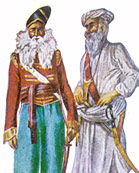Consolidation

A statute passed in the year 1778 raised the strength of the police in Calcutta to 700 paiks, 31 thanadars and 34 naibs under a superintendent. In 1780 commissioners of conservancy were appointed for the town who also looked after watch and ward. Policing was, still very loosely organized.
In 1794 justices of peace were appointed for the municipal administration of Calcutta and its suburbs, under a chief magistrate who was directly in charge of the Police. In 1806 justices of peace were constituted as magistrates of 24 Parganas and parts of the adjacent districts within a 20-mile radius of the town.
The middle decades of the 19th century witnessed a greater systematization and institutionalization of policing in Calcutta. William Coats Blacquiere, a charismatic city magistrate inaugurated a network of spies or “goendas“. In 1845 a committee under J.H. Patton brought about key changes in police organisation which now began to be modeled on the London Metropolitan Police. A Commissioner of Police was appointed with powers of a justice of peace to preserve law and order, detect crime and apprehend offenders.
